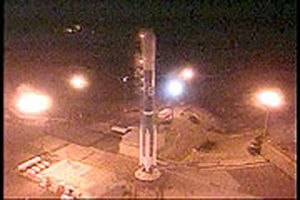Launch Pad Glitch Prompts Third Delay for NOAA-N Weather Probe

Today'sscheduled California liftoff of the Boeing Delta 2 rocket to deploy the latestpolar-orbiting weather satellite was scrubbed by electrical gremlins in thesystem that floods the launch pad with critical cooling and sound-dampeningwater during the fiery blastoff.
"We have scrubbed forthe day due to insufficient time to deal with an electrical problem at thelaunch pad associated with the water deluge system pumps and the electrical systemfeeding the pump house," NASA spokesman George Diller said.
After back-to-backpostponements for strong winds that prevented retracting the pad's servicetower on Tuesday and Wednesday evenings, this third countdown appeared to begoing smoothly. But engineers began wrestling with the pump problems as clocksentered the final hours.
Officials delayed loadingsuper-cold liquid oxygen into the rocket's first stage while troubleshootingcontinued at Vandenberg Air Force Base's Space Launch Complex-2 West pad. Inthe end, the prospect of performing the repair job, fueling the rocket andcompleting the countdown for liftoff during the day's tight 10-minute launchwindow was too much to accomplish.
The Delta rocket mustlaunch between 1022:01 and 1032:01 GMT (6:22:01-6:32:01 a.m. EDT;3:22:01-3:32:01 a.m. PDT) to haul the 3,100-pound NOAA-N weather satellite intoits precise polar orbit, leaving little margin to deal with last-minute issuesthat arise in the countdown.
"We have a decision byBoeing Mission Director Rich Murphy and NASA Launch Manager Omar Baez that wewill scrub for today," Diller announced from the management control centerat 0900 GMT. "There is not enough time to complete the work necessary atthe pump house to resolve the electrical problems and still meet our launchwindow. This is currently planned to be a 24-hour scrub."
This will be the SLC-2W pad's first launch in almost a year. The most recentmission came last July when a Delta 2 booster launched NASA'sAura environmental satellite.
Get the Space.com Newsletter
Breaking space news, the latest updates on rocket launches, skywatching events and more!
Aside from the pad glitch,there were no significant problems reported with the rocket, NOAA-N spacecraftor Range during today's countdown. Although the launch site was covered with adense layer of fog, weather conditions were acceptable for flight, too.
The weather forecast forSaturday's launch opportunity calls for another foggy morning with stratusclouds hanging over Vandenberg at 500 feet and tops at 1,500 feet, three milesof visibility, temperatures in the low 50's F, northerly winds at 10 to 15knots. There is a zero percent chance of violating the launch weather rules.
The target launch timeremains the same on Saturday -- 1022 GMT (6:22 a.m. EDT; 3:22 a.m. PDT).
The NOAA-N spacecraft,built by Lockheed Martin, will orbit 540 miles above the planet to providemeteorologists with imagery, temperature measurements and atmospheric profilesneeded for weather forecasting. The satellite will replace the aging NOAA-16craft, launched in September 2000, that has experienced some instrument problemsand well-surpassed its two-year design life.
NOAA-N, which will berenamed NOAA-18 upon its successful delivery in space, builds upon 45 years ofweather monitoring by U.S. polar-orbiting satellites.
This particular satellite,its instruments, Delta rocket and assorted support costs amount to $341million.
You can follow Saturday'searly morning countdown and the ascent to orbit in our live Mission StatusCenter.

Join our Space Forums to keep talking space on the latest missions, night sky and more! And if you have a news tip, correction or comment, let us know at: community@space.com.
Justin Ray is the former editor of the space launch and news site Spaceflight Now, where he covered a wide range of missions by NASA, the U.S. military and space agencies around the world. Justin was space reporter for Florida Today and served as a public affairs intern with Space Launch Delta 45 at what is now the Cape Canaveral Space Force Station before joining the Spaceflight Now team. In 2017, Justin joined the United Launch Alliance team, a commercial launch service provider.
